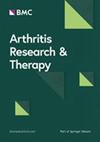Quercetagetin alleviates inflammatory osteoclastogenesis and collagen antibody-induced arthritis via Nrf2 signaling and Pten/AKT/Nfatc1 axis
IF 4.9
2区 医学
Q1 Medicine
引用次数: 0
Abstract
Quercetagetin, a flavonoid derived from the natural herb Flos eriocauli, is used in traditional Chinese medicine for its fire-purging (anti-inflammation) and wind-expelling (pain-alleviating) properties. However, its potential effects concerning rheumatoid arthritis (RA) remain underexplored. This study was designed to elucidate the potential associations between Quercetagetin and RA, establishing the therapeutic potential of Quercetagetin and related mechanisms in RA treatment. Network pharmacology was conducted to decipher related targets and signaling pathways between Quercetagetin and RA. In vitro assays were then conducted to explore the effects of Quercetagetin on osteoclast cell behaviors and corresponding signaling pathways. In vivo study further validated the therapeutic effect of Quercetagetin in collagen antibody-induced arthritis (CAIA) mice. The network pharmacological analysis indicated an intimate correlation of Quercetagetin with RA-related inflammatory osteolysis treatment. Pertaining to biological validations, 2 µM of Quercetagetin successfully inhibited LPS-driven osteoclast differentiation and function. qPCR assay and Western blot analyses denoted parallel changes in osteoclastic marker genes and proteins. Further mechanism study uncovered the effect of Quercetagetin in stimulating the Nrf2/Keap1 signaling pathway and moderating the Pten/AKT/Nfatc1 axis in osteoclasts. In vivo study revealed 40 mg/kg Quercetagetin every day could significantly relief joint destruction in CAIA mice. Our study presents Quercetagetin ‘s therapeutic potential in treating RA, outlining its effects and potential mechanisms in suppressing LPS-induced osteoclast activity, and alleviating inflammatory bone destruction in CAIA model, thereby laying the groundwork for further translational research on Quercetagetin and Flos eriocauli in RA treatment. Quercetagetin extracted from Flos eriocauli displayed brilliant anti-osteoclast and anti-inflammation potential during rheumatoid arthritis. Quercetagetin significantly repressed lipopolysaccharide-stimulated osteoclast behavior from phenotypical and molecular level. Quercetagetin mitigated inflammatory bone destruction in collagen antibody-induced arthritis.槲皮素通过Nrf2信号和Pten/AKT/Nfatc1轴缓解炎性破骨细胞生成和胶原抗体诱导的关节炎
槲皮素是一种从天然草本植物黄花中提取的类黄酮,因其清火(抗炎)和祛风(缓解疼痛)的特性而被用于中药中。然而,其对类风湿关节炎(RA)的潜在影响仍未得到充分研究。本研究旨在阐明槲皮素与RA的潜在关联,确立槲皮素治疗RA的潜力及相关机制。网络药理学分析槲皮素与RA之间的相关靶点和信号通路。体外实验探讨槲皮素对破骨细胞行为及相关信号通路的影响。体内实验进一步验证了槲皮素对胶原抗体性关节炎(CAIA)小鼠的治疗作用。网络药理学分析表明槲皮素与ra相关的炎症性溶骨治疗密切相关。根据生物学验证,2µM槲皮素成功抑制了lps驱动的破骨细胞分化和功能。qPCR和Western blot分析显示破骨细胞标记基因和蛋白的平行变化。进一步的机制研究揭示了槲皮素在破骨细胞中刺激Nrf2/Keap1信号通路和调节Pten/AKT/Nfatc1轴的作用。体内研究显示,槲皮素每天40 mg/kg可显著缓解CAIA小鼠关节损伤。我们的研究揭示了槲皮素治疗RA的潜力,概述了槲皮素在抑制lps诱导的破骨细胞活性、减轻CAIA模型炎症性骨破坏中的作用及其可能机制,从而为槲皮素和鸢子花治疗RA的进一步转化研究奠定了基础。槲皮素在类风湿关节炎中表现出良好的抗破骨和抗炎作用。槲皮素从表型和分子水平显著抑制脂多糖刺激的破骨细胞行为。槲皮素减轻胶原抗体诱导关节炎的炎性骨破坏。
本文章由计算机程序翻译,如有差异,请以英文原文为准。
求助全文
约1分钟内获得全文
求助全文
来源期刊

Arthritis Research & Therapy
RHEUMATOLOGY-
CiteScore
8.60
自引率
2.00%
发文量
261
审稿时长
14 weeks
期刊介绍:
Established in 1999, Arthritis Research and Therapy is an international, open access, peer-reviewed journal, publishing original articles in the area of musculoskeletal research and therapy as well as, reviews, commentaries and reports. A major focus of the journal is on the immunologic processes leading to inflammation, damage and repair as they relate to autoimmune rheumatic and musculoskeletal conditions, and which inform the translation of this knowledge into advances in clinical care. Original basic, translational and clinical research is considered for publication along with results of early and late phase therapeutic trials, especially as they pertain to the underpinning science that informs clinical observations in interventional studies.
 求助内容:
求助内容: 应助结果提醒方式:
应助结果提醒方式:


